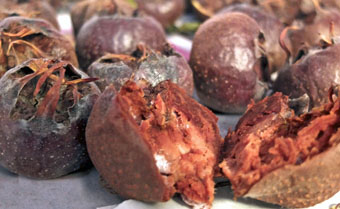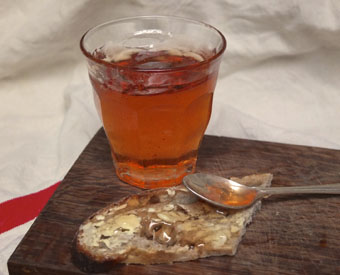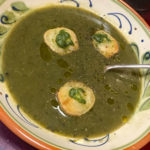
Medlars are not something easily found in the market, at least not that I have ever seen. You need your own medlar tree, or know someone who has one, in which case, in my experience, they will be keen for you to help yourself.
Medlar, much like the quince, or rather even more so, has slipped away from modern culinary favour.
It wasn’t always so, medlars were popular in Victorian cuisine and in literature there are various references made to the medlar (notably Chaucer and Shakespeare), usually to describe a person in a derogatory sense, as the medlar has to rot before it is edible. This rotting process is called bletting, basically when the hard fruit has sat around in a room long enough for it to soften and resemble what was affectionately referred to in medieval times as a ‘cat’s arse’ or ‘open arse’.

This year our neighbour gave us a huge bag of medlars that they had picked from their son’s tree. They sat on our living room table on newspaper for what seemed like an eternity (probably about a month) before they were properly ‘bletted’ and the room filled with their sweet, musty smell, which seemed to linger long after they’d gone, or rather were made into medlar jelly.

The jelly is lovely served with fowl and game, but can also be spread onto your morning toast. Here is the recipe:
- 1 kg medlars
- Juice of ½ lemon
- Caster sugar
- Vanilla pod.
- Some recipes also add a sour apple for added pectin.
Wash the medlars and cut in half. Then put them into a heavy based saucepan with the lemon juice and cover with water and bring to the boil. Turn down the heat and simmer for an hour, giving them a nudge with a wooden spoon every now and then, but not too hard as otherwise your jelly will end up cloudy.
Turn off the heat and let the fruit and water cool down and then put them into a colander lined with cheesecloth, or suspend the cheesecloth from the four legs of an upside down chair, over a large bowl and leave for at least 12 hours.
Next measure the juice and put into a clean pan with equal amounts of sugar (1 litre of juice to 1 kg sugar), split the vanilla pod and add.
Put a saucer or small plate into the freezer.
Heat the juice and sugar gently until the sugar has melted and then turn up the heat to a fast rolling boil. After five minutes, take the saucer out of the freezer and drop a dollop of the syrup onto it, if it wrinkles after a minute when you push it with your finger, the jelly is set, if not boil for another five minutes and test again.
When you’re satisfied that the jelly is ready, pour into sterilized jars (I first wash my jars and then put them in the oven at 100°c whilst the jelly is cooking). If by the next morning you find that the jelly hasn’t set (like mine hadn’t) you can pour it back into a pan and boil for another five minutes, or just accept it as runny and use for adding to gravy and sauces.

http://www.theguardian.com/lifeandstyle/2006/dec/03/foodanddrink.recipes/
http://www.telegraph.co.uk/food-and-drink/recipes/medlar-jelly/
https://en.wikipedia.org/wiki/Mespilus_germanica
http://www.davidlebovitz.com/2012/11/medlar-jelly-recipe/
















Leave a Reply